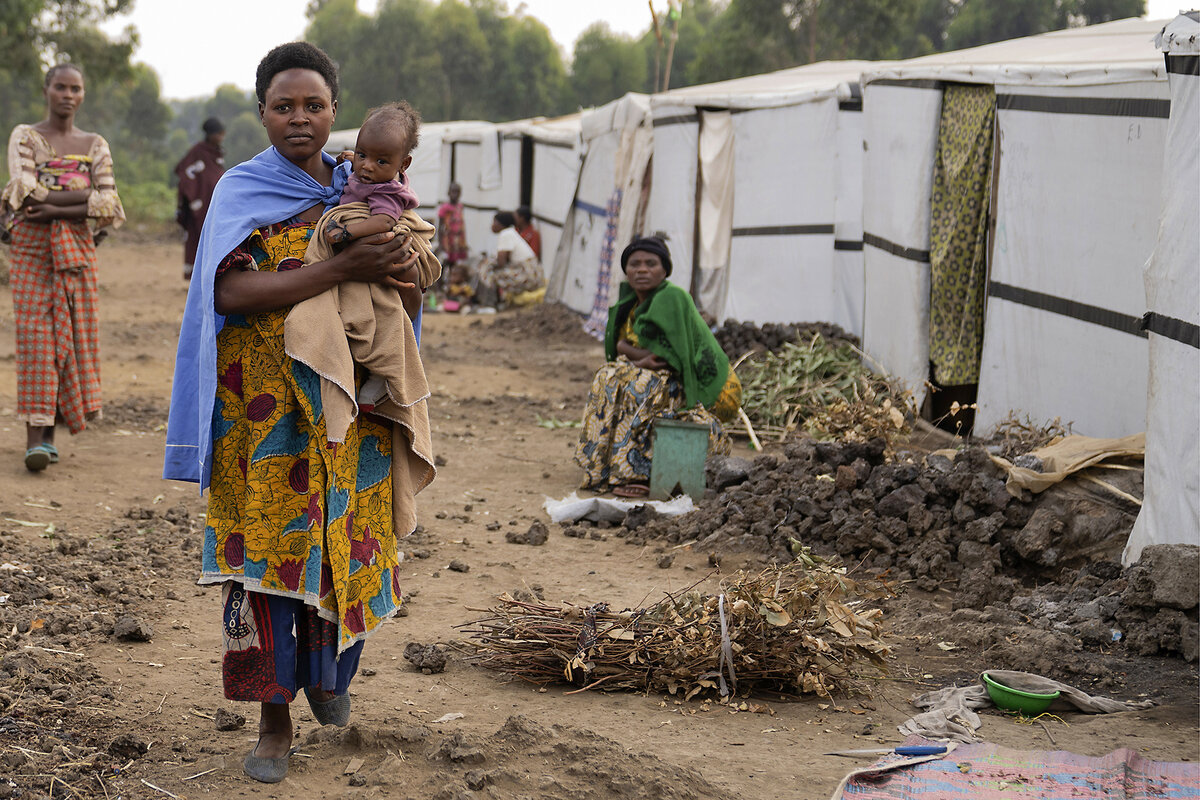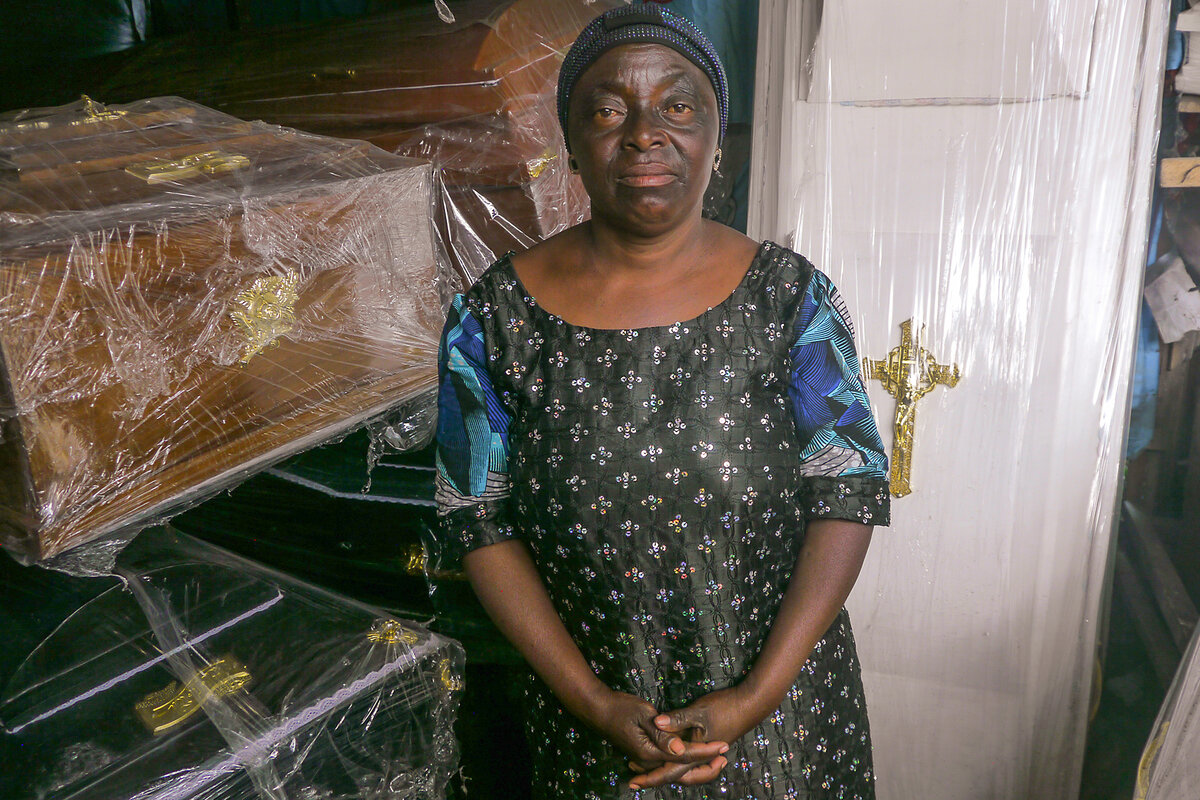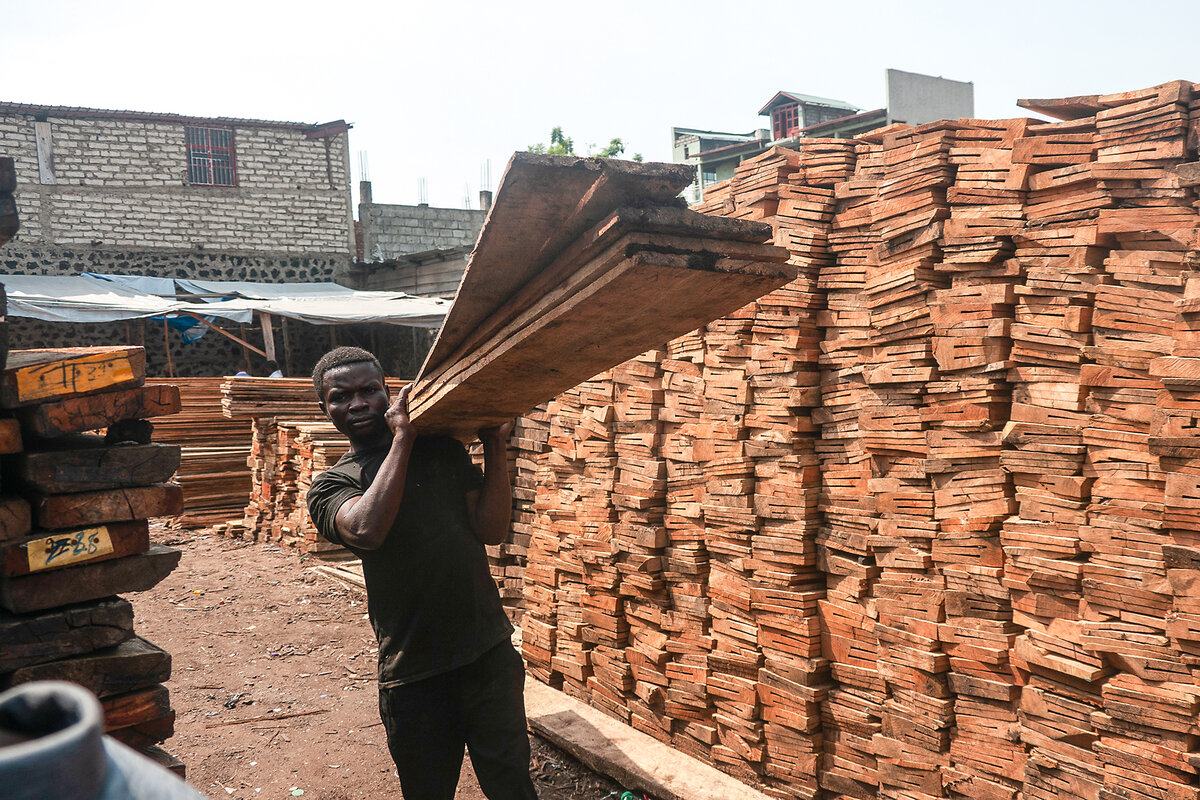Senseless deaths mount in Congo. Dignified mourning helps salve the pain.
Loading...
| Goma, Congo
Justin was the first of the Ndayambajes’ children to die.
Last year, the 7-year-old was helping his mother gather firewood outside their displacement camp in the eastern Democratic Republic of Congo when he was struck by a stray bullet from militia fighters doing target practice in the area.
Residents of a neighboring village brought his small body back to his family’s tent as his mother trailed behind in tears.
Why We Wrote This
A story focused onA death toll is a simple way to convey to outsiders how devastating a conflict is. But the dead are not merely statistics. In eastern Congo, communities are finding ways to make sure that each life cut short by war is remembered and mourned with dignity.
At a roadside stall, his father, Jean Ndayambaje, selected a minuscule coffin. Then, on the grounds of a crowded cemetery thick with purple wildflowers, he dug Justin’s grave himself. Two hundred mourners gathered at the plot to sing and pray.
Many of those who came to the funeral had known similar losses themselves. Over the last two years, a Rwandan government-backed rebellion by guerrilla forces known as the March 23 Movement (M23) has uprooted 1.7 million civilians in eastern Congo. Thousands have died, either directly because of the fighting or from the hunger and illness that have followed in its wake.
For many here, mourning with dignity is a way to remind themselves that even if their loved ones’ deaths were senseless and random, their lives still meant something.
“He was very kind, and never made trouble,” says Mr. Ndayambaje of Justin, whose grave site he visits every second week to clean. “Whenever the other children wanted to fight with him, he came straight to tell his papa.”
No life unnoticed
In a worn blue notebook, Gilbert Maombi Sebuhoro keeps a list of the dead.
By the time he added Justin’s, there were already hundreds of names inscribed there. For each one, he noted the age and cause of death in sloping handwriting, a careful archive of lives cut short by war.
Mr. Sebuhoro is the secretary of the displacement camp where the Ndayambajes live, a dense tangle of tents made from frayed plastic and bits of wood on the edge of the lakeside city of Goma.
Since 2022, tens of thousands of people have taken shelter on the city’s edges, which have become the last safe place left to run to as fighting between M23, the Congolese army, and various government-aligned militias escalates.
Mr. Sebuhoro, who arrived shortly after the conflict began, chronicles deaths in 118 displacement sites near Goma. Today, his list has over 1,000 entries. He says it is essential that no matter how many people die, no life goes unnoticed.
“If someone is dead here, I can’t stay in my tent,” he says. “We call every neighbor and family member, and we spend the night at the place where the dead man lived.”
Crafting coffins
Denise Iru Kahambu also knows what it is like to mourn someone you love.
In 1997, during the First Congo War, her husband died fighting on behalf of dictator Mobutu Sese Seko, leaving her to raise their children alone. Eventually, to support them, Ms. Kahambu started a small business selling coffins in Goma.
“I have mercy for the displaced people,” she says, surrounded by neat stacks of white painted caskets. “I feel sorry for them.”
For that reason, she gives coffins away to any uprooted family that asks her for one – about a dozen of them every week.
The Congolese government is supposed to reimburse her, but when the Monitor visited her in July, Ms. Kahumbu said that she was still owed the cost of 60 coffins.
Meanwhile, the price of timber is soaring as conflict blocks the roads leading in and out of Goma, with rebels and government soldiers alike demanding payment from merchants brave enough to cross checkpoints with their wares. The price of wood has gone up 40% since the war began, according to local merchants.
This makes it harder for Ms. Kahambu to buy materials for her coffins, or make a profit from the ones she does not give away. Sometimes, she wonders how long she will be able to continue her work.
“I want to keep providing coffins, but at a certain point I won’t be able to,” she says.
Far from home
Still, the need continues to grow.
While he was still mourning the loss of his son, Mr. Ndayambaje’s 6-year-old daughter, Neema, became ill with typhoid from drinking dirty water.
In June, he laid her to rest in the same cemetery as her brother.
Afterward, his friends gathered outside the family’s tent to mourn. Mr. Ndayambaje had to borrow money to pay for drinks for them. He does not know how he will pay it back.
The pain of his daughter’s death is compounded, he adds, by having to leave his children in graves so far from where they were born.
“You feel a bit more comfortable when you bury your relatives nearby your home, because you can always see the place,” Mr. Ndayambaje says, watching other children scrambling over loose rocks as they chase each other through the camp. “When you bury someone far from home, you will never see [the grave] again. It’s very sad.”
Mr. Ndayambaje’s sentiments are echoed by Jean-Bosco Simbahunga, another resident of the camp, whose aging father died after an illness in April.
“We’d like to go back to our village and even be buried in our village,” Mr. Simbahunga says. “I feel as if we are all going to die here and be buried here.”
Mr. Simbahunga says his father was a kind man who valued education and eagerly volunteered in his church.
In the rush to bury him, Mr. Simbahunga forgot to study exactly where the grave site was within a sprawling cemetery allocated for displaced people.
Since then, he has not been able to find his father again.
Reporting for this story was supported by the Pulitzer Center.








